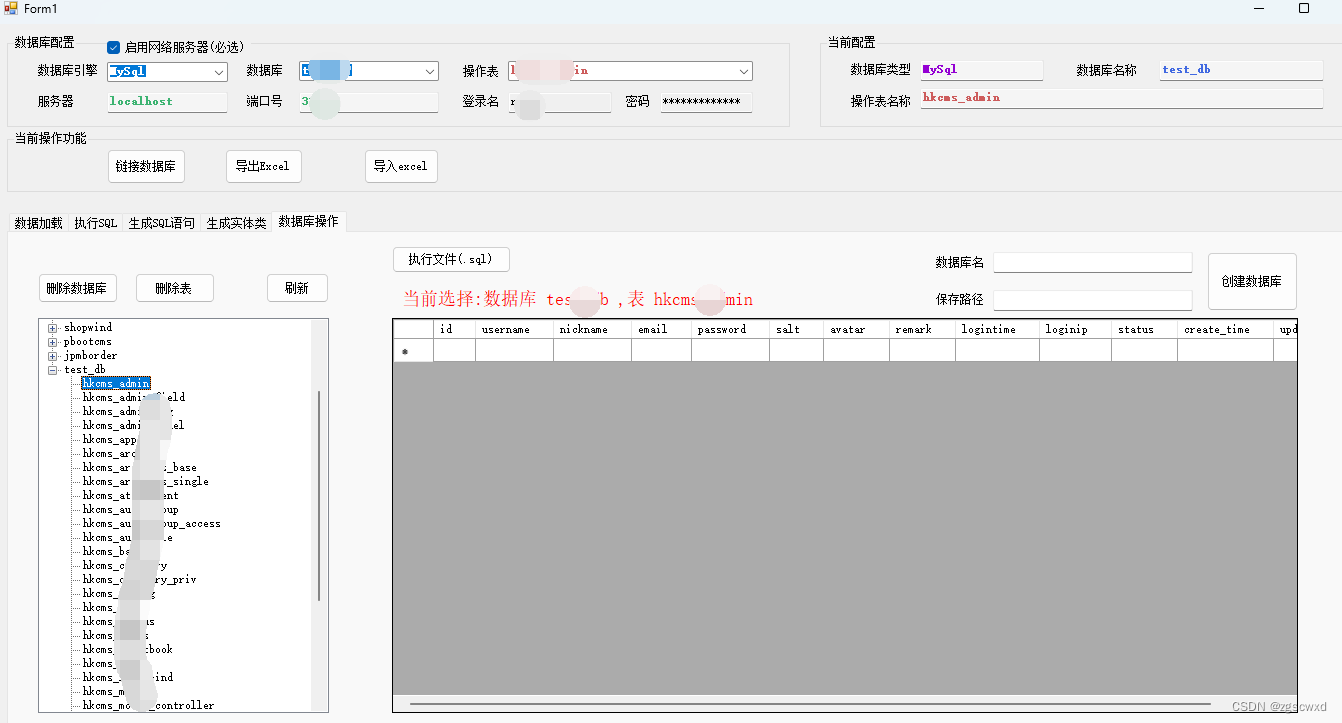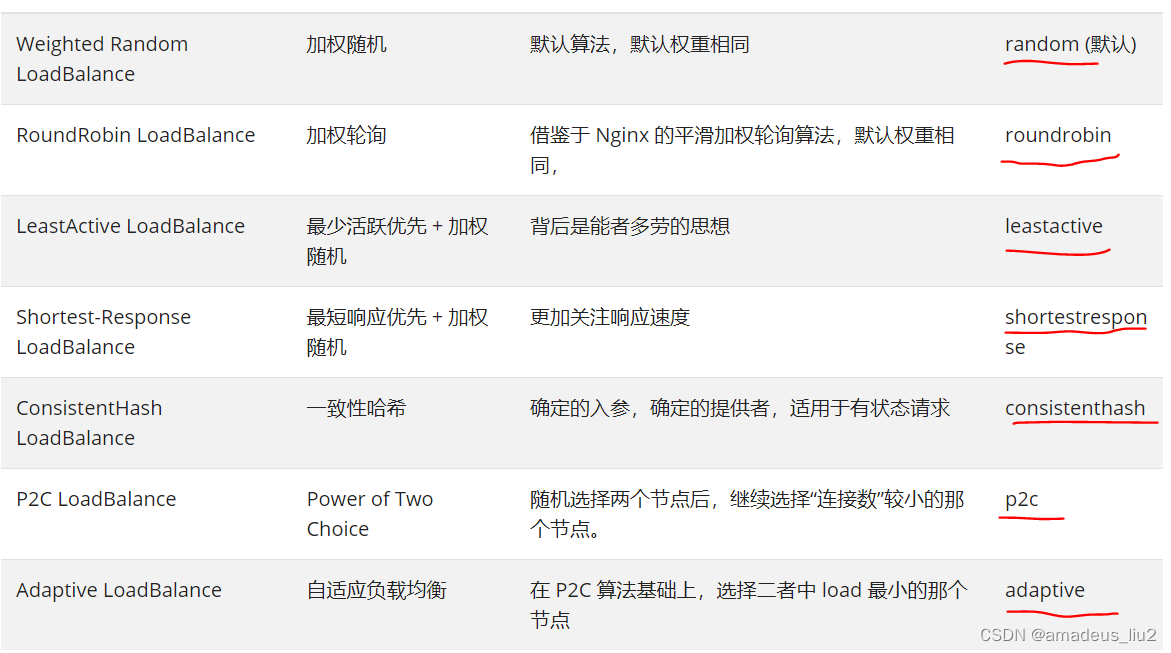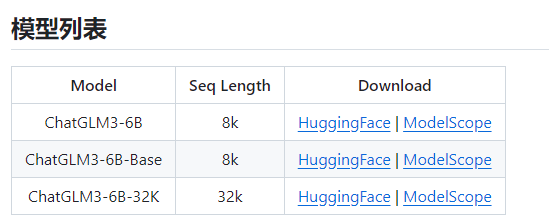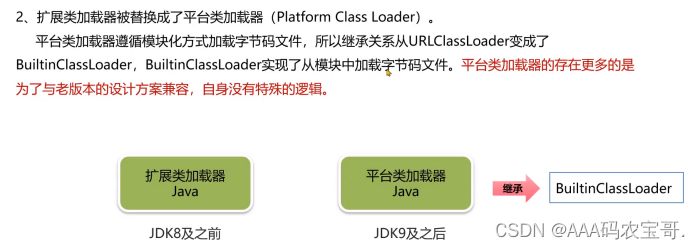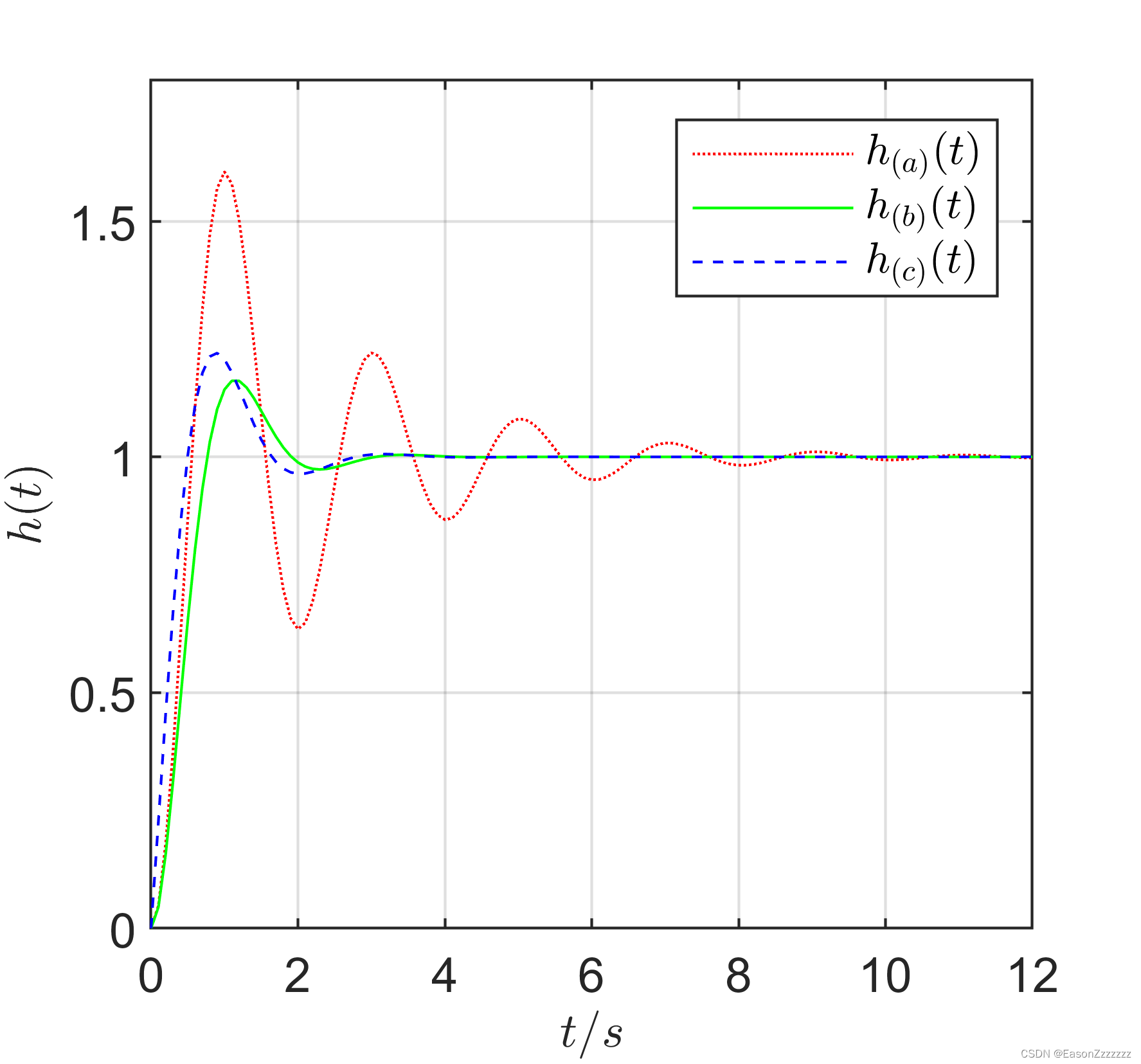前言
思路及算法思维,指路 代码随想录。
题目来自 LeetCode。
day 16,周四,再坚持一下吧~
题目详情
[104] 二叉树的最大深度
题目描述
104 二叉树的最大深度
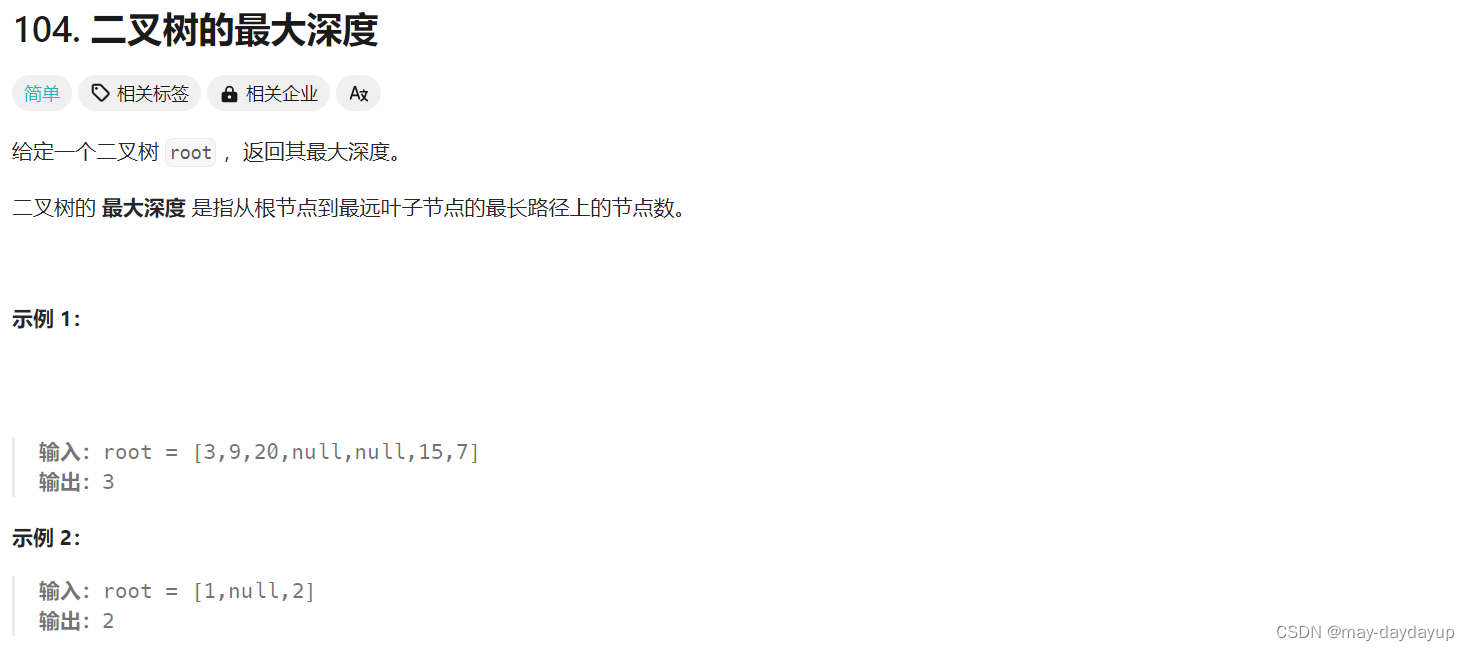
解题思路
前提:二叉树的最大深度,等价于二叉树的层数,等价于求最底层二叉树叶子结点的高度。
思路:求二叉树深度:前序遍历;求二叉树高度:后序遍历;求二叉树层数:层级遍历。
重点:二叉树节点的深度:指从根节点到该节点的最长简单路径边的条数或者节点数(取决于深度从0开始还是从1开始);二叉树节点的高度:指从该节点到叶子节点的最长简单路径边的条数或者节点数(取决于高度从0开始还是从1开始)。
代码实现
C语言
层级遍历 队列
/**
* Definition for a binary tree node.
* struct TreeNode {
* int val;
* struct TreeNode *left;
* struct TreeNode *right;
* };
*/
int maxDepth(struct TreeNode* root) {
int ans = 0;
// 判断树非空
if (root == NULL)
{
return ans;
}
// 层级遍历, 队列
struct TreeNode *queue[10000];
int idx = 0;
queue[idx++] = root;
int start = 0;
while (start < idx)
{
int levelCnt = idx - start;
for (int i = 0; i < levelCnt; i++)
{
struct TreeNode *cur = queue[start++];
if (cur->left)
{
queue[idx++] = cur->left;
}
if (cur->right)
{
queue[idx++] = cur->right;
}
}
ans++;
}
return ans;
}
后序遍历 求root的高度,递归
/**
* Definition for a binary tree node.
* struct TreeNode {
* int val;
* struct TreeNode *left;
* struct TreeNode *right;
* };
*/
int max(int a, int b)
{
return (a > b) ? a : b;
}
int hight(struct TreeNode* root)
{
// 后序遍历求高度,最大深度即为root的高度
if (root == NULL)
{
return 0;
}
int leftHight = hight(root->left);
int rightHight = hight(root->right);
return 1 + max(leftHight, rightHight);
}
int maxDepth(struct TreeNode* root) {
// 后序遍历求高度,最大深度即为root的高度,递归
return hight(root);
}
前序遍历 求root深度,递归
/**
* Definition for a binary tree node.
* struct TreeNode {
* int val;
* struct TreeNode *left;
* struct TreeNode *right;
* };
*/
int max(int a, int b)
{
return (a > b) ? a : b;
}
void depthFun(struct TreeNode* root, int depth, int *result)
{
// 前序遍历求深度, 注意回溯的过程
if (root == NULL)
{
return ;
}
*result = max(*result, depth);
depthFun(root->left, depth + 1, result);
depthFun(root->right, depth + 1, result);
return ;
}
int maxDepth(struct TreeNode* root) {
// 后序遍历求高度,最大深度即为root的高度,递归
int result = 0;
int depth = 0;
depthFun(root, depth + 1, &result);
return result;
}
[111] 二叉树的最小深度
题目描述
111 二叉树的最小深度
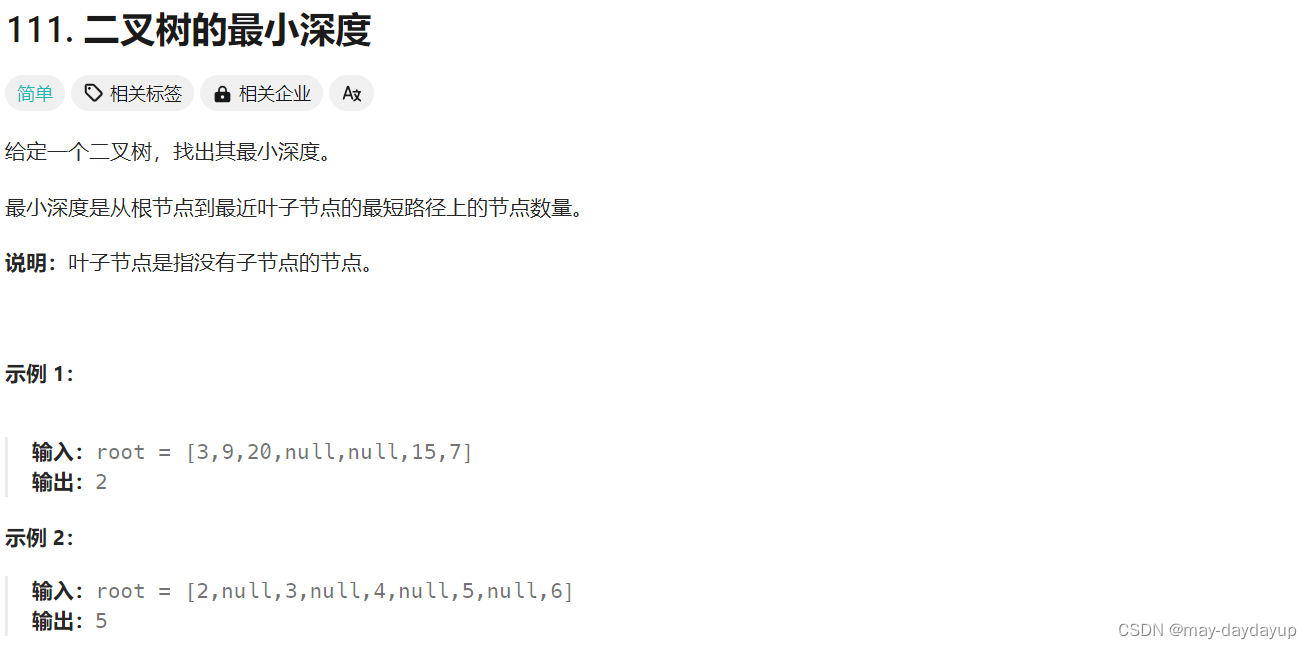
解题思路
前提:二叉树的最小深度,等价于二叉树最高层叶子结点的层数,等价于求二叉树最高层叶子结点的高度。
思路:求二叉树深度:前序遍历;求二叉树高度:后序遍历;求二叉树层数:层级遍历。
重点:注意叶子结点的含义: (node->left == NULL) && (node->right == NULL)。
代码实现
C语言
层序遍历,队列
/**
* Definition for a binary tree node.
* struct TreeNode {
* int val;
* struct TreeNode *left;
* struct TreeNode *right;
* };
*/
int minDepth(struct TreeNode* root) {
int ans = 0;
// 判断空树
if (root == NULL)
{
return ans;
}
// 层序遍历,队列
struct TreeNode *queue[100000];
int idx = 0;
queue[idx++] = root;
int start = 0;
while (start < idx)
{
int levelCnt = idx - start;
ans++;
for (int i = 0; i < levelCnt; i++)
{
struct TreeNode *cur = queue[start++];
// 判断是否为叶子结点
if ((cur->left == NULL) && (cur->right == NULL))
{
// 找到第一个叶子结点,直接退出
return ans;
}
if (cur->left)
{
queue[idx++] = cur->left;
}
if (cur->right)
{
queue[idx++] = cur->right;
}
}
}
return ans;
}
前序遍历深度,递归
/**
* Definition for a binary tree node.
* struct TreeNode {
* int val;
* struct TreeNode *left;
* struct TreeNode *right;
* };
*/
int minFun(int a, int b)
{
return (a < b) ? a : b;
}
void depthFun(struct TreeNode* root, int depth, int *result)
{
if (NULL == root)
{
return ;
}
// 寻找叶子结点
if ((root->left == NULL) && (root->right == NULL))
{
*result = minFun(*result, depth);
return ;
}
depthFun(root->left, depth + 1, result);
depthFun(root->right, depth + 1, result);
}
int minDepth(struct TreeNode* root) {
// 判断空树
if (root == NULL)
{
return 0;
}
int ans = INT_MAX;
// 前序遍历,递归
depthFun(root, 1, &ans);
return ans;
}
[222] 完全二叉树的节点个数
题目描述
222 完全二叉树的节点个数

解题思路
前提:在完全二叉树中,除了最底层节点可能没填满外,其余每层节点数都达到最大值,并且最下面一层的节点都集中在该层最左边的若干位置。若最底层为第 h 层,则该层包含 1~ 2^(h-1) 个节点。
思路:普通二叉树遍历;利用完全二叉树特性,拆解为n个满二叉树,利用 2^树深度 - 1 来计算。
重点:完全二叉树的特性。
代码实现
C语言
普通二叉树 先序遍历 递归
/**
* Definition for a binary tree node.
* struct TreeNode {
* int val;
* struct TreeNode *left;
* struct TreeNode *right;
* };
*/
void travesal(struct TreeNode *root, int *ans)
{
if (root == NULL)
{
return ;
}
//先序遍历
(*ans)++;
travesal(root->left, ans);
travesal(root->right, ans);
}
int countNodes(struct TreeNode* root) {
int ans = 0;
travesal(root, &ans);
return ans;
}
普通二叉树 结点数量 递归
/**
* Definition for a binary tree node.
* struct TreeNode {
* int val;
* struct TreeNode *left;
* struct TreeNode *right;
* };
*/
int countNodeNum(struct TreeNode *root)
{
if (root == NULL)
{
return 0;
}
int leftNum = countNodeNum(root->left);
int rightNum = countNodeNum(root->right);
return (leftNum + rightNum + 1);
}
int countNodes(struct TreeNode* root) {
int ans = countNodeNum(root);
return ans;
}
完全二叉树分解成满二叉树,利用满二叉树结点数为2^n -1。
/**
* Definition for a binary tree node.
* struct TreeNode {
* int val;
* struct TreeNode *left;
* struct TreeNode *right;
* };
*/
int countNodeNum(struct TreeNode *root)
{
if (root == NULL)
{
return 0;
}
int leftDepth = 0;
int rightDepth = 0;
struct TreeNode *left = root->left;
struct TreeNode *right = root->right;
// 求左侧叶子结点的深度
while (left)
{
leftDepth++;
left = left->left;
}
// 求右侧叶子结点的深度
while (right)
{
rightDepth++;
right = right->right;
}
// 判断是否为满二叉树, 两边深度相同
// 注意:两侧深度相同的二叉树不是满二叉树,但两侧深度相同的完全二叉树,一定是满二叉树。
if (leftDepth == rightDepth)
{
return (2 << leftDepth) - 1;
}
int leftNum = countNodeNum(root->left);
int rightNum = countNodeNum(root->right);
return (leftNum + rightNum + 1);
}
int countNodes(struct TreeNode* root) {
int ans = countNodeNum(root);
return ans;
}
今日收获
- 二叉树的深度、高度;
- 完全二叉树的特性。
